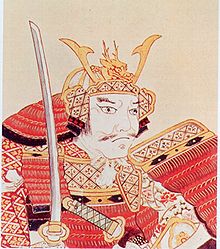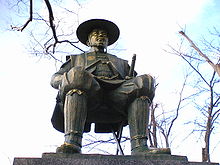
Nanbu Clan
Share
The Nanbu clan (南部氏 Nanbu-shi) was a Japanese clan that ruled much of the northern part of the Tōhoku region for over 700 years, from the Kamakura shogunate until the Meiji renewal.
The clan claimed to be descended from the Seiwa Genji of Kai province where they were related to the Takeda clan.
The clan moved from Kai province to Mutsu province at the beginning of the Muromachi period and were confirmed as daimyō of the Morioka domain by the Tokugawa shogunate at the beginning of the Edo period.
They were in constant conflict with the Ōura clan who were previously servants of the Nanbu.
During the Boshin War (1868-69) the Nanbu clan sided with the Ōuetsu Reppan Dōmei thus supporting the Tokugawa regime.
With the Meiji Restoration and the abolition of the han system, the Nanbu saw their lands confiscated and the last daimyō of the clan was appointed Count under the new hereditary system of Kazoku nobility.
The main line of the clan still survives to the present day; Toshiaki Nanbu serves as a priest at the Yasukuni Shrine.
Nanbu Clan Origins
The Nanbu clan claimed to be descended from the Seiwa Genji of Kai province. Kai province was assigned to Minamoto no Yoshimitsu after the Gosannen War, and his great-grandson Nobuyoshi took the surname Takeda.
Another of his grandsons, Mitsuyuki, took the surname "Nanbu" after he was assigned property in Kai province that is now part of the city of Nanbu (Yamanashi).
Nanbu Mitsuyuki joined Minamoto Yoritomo in the Battle of Ishibashiyama, served in several mid-ranking positions within the Kamakura shogunate, and is mentioned several times in the Azuma Kagami.
He was at Yoritomo's side in the conquest of Hiraizumi Fujiwara in 1189, and was given vast estates in the Nukanobu district, extreme northeastern Honshū, where he built Shōjujidate Castle in what is now the town of Nanbu (Aomori).
The area was rich in ranches and horses, and the Nanbu quickly grew rich and powerful through the sale of war horses. These ranches were fortified, numbered from one to nine, and assigned to Nanbu Mitsuyuki's six sons, thus creating the six main branches of the Nanbu clan.
During the Nanboku-chō period, after the fall of the Kamakura shogunate in 1333, Nanbu Motoyuki accompanied Kitabatake Akiie to the north when he was appointed commander-in-chief of the northern defense and Shugo of Mutsu province.
Nanbu Motoyuki built Ne Castle, which was to be a center for the administration of the imperial government in the area. This officially marked the transfer of the Nanbu clan from Kai province to Mutsu province.
Nanbu Motoyuki swore allegiance to the Southern Court; however, at the same time, another branch of the same Nanbu family that ruled the nearby areas of Sannohe and Morioka swore allegiance to the Northern Court. The two branches of the clan made peace in 1393.
Nanbu Clan in Sengoku Period

Although the Nanbu clan, at the time commanded by the XXIV chief Nanbu Harumasa, controlled seven districts in the northern province of Mutsu (Nukanobu, Hei, Kazuno, Kuji, Iwate, Shiwa, and Tōno), it was mostly made up of various branches that boasted a certain amount of independence without central control.
This weakness was exploited by the Ōura clan, a cadet branch of the Nanbu that later changed its name to the Tsugaru clan, which rebelled in 1572.
Ōura Tamenobu was deputy district magistrate under local magistrate Ishikawa Takanobu of the Nanbu clan; he attacked and killed Ishikawa and began conquering Nanbu clan castles.
Tamenobu also attacked Kitabatake Akimura (another figure who enjoyed some power locally) and conquered Namioka Castle.
The struggle between the Ōura clan and the Nanbu clan, which began with Nanbu Nobunao, continued for the next two centuries. In 1590, Tamenobu swore allegiance to Toyotomi Hideyoshi; Hideyoshi confirmed Tamenobu's fiefs, making it permanently independent of the Nanbu clan.
Because Tamenobu's fief was located in the Tsugaru region on the northwestern tip of Honshū, the Ōura clan changed its name to "Tsugaru".
After the death of Nanbu Harumasa in 1582, the clan split into several warring factions. In 1590, the Sannohe faction led by Nanbu Nobunao organized a coalition with most branches of the Nambu clan and pledged allegiance to Toyotomi Hideyoshi during the siege of Odawara.
In return he was recognized as the leader of the Nanbu clan and confirmed as daimyō of his lands (with the exception of Tsugaru). However, Kunohe Masazane, who felt he had more right to be elected clan chief, began a rebellion.
Kunohe's rebellion was quickly suppressed and Hideyoshi rewarded the Nanbu for the loss of Tsugaru with the addition of Hienuki and Waga districts. Nanbu Nobunao moved his stronghold from Sannohe Castle to the more central location of Morioka Castle in 1592.
Nanbu Clan in Edo Period

The Nanbu clan allied itself with Tokugawa Ieyasu's Eastern Army during the Battle of Sekigahara. Following Ieyasu's victory, the Nanbu clan was confirmed in the domain of Morioka (盛岡藩 Morioka-han) (also known as the domain of Nanbu (南部藩 Nanbu-han).
The value of the domain was officially 100,000 koku, but later in the Edo period it was doubled. The Nanbu clan maintained its lands throughout the Edo period and survived until the Meiji Restoration.
During the Edo period, two new branches of the Nanbu clan were founded, one in Hachinohe and the other in Shichinohe.
In 1821, old tensions between Nanbu and Tsugaru were once again reawakened in the wake of the Sōma Daisaku incident (相馬大作事件 Sōma Daisaku jiken), a failed plot by Sōma Daisaku, an old servant of the Nanbu clan, to assassinate the Tsugaru chief.
Nanbu clan territories were among those affected by the Tenpo-era famine of the mid-1930s.
Like many other domains in northern Honshū, the Morioka domain was assigned by the shogunate to police the Ezochi (now Hokkaidō) border region.
The clan's first direct encounter with foreigners occurred in the late 16th century, when a Dutch ship, the Breskens, arrived in Nanbu territory. A group of sailors who had departed from the ship were captured by local authorities and taken to Edo.
Throughout the course of history, especially in the Edo period, several servants of the Nanbu clan became nationally famous. Sado Narayama, a clan elder (karō) who was active during the Boshin War, was one of them;
he was responsible for the Nanbu clan's political activity and interaction with neighboring domains. Hara Takashi, who later became prime minister of Japan, was another prominent figure in the Nanbu clan.
Some figures in 20th-century Japanese politics also came from various Nanbu servant families; perhaps the best known were Seishirō Itagaki and Hideki Tōjō.
Nanbu Clan in Boshin War
During the Boshin War of 1868-69, the Nanbu clan initially attempted to remain neutral. However, under the leadership of Nanbu Toshihisa and karō Sado Narayama, the clan became part of the Ōuetsu Reppan Dōmei alliance that supported the shogunate.
On September 23, 1868, Nanbu clan troops joined in the attack on the Akita domain, which had split from the alliance and allied itself with the imperial government. By October 7, the Nanbu troops conquered Ōdate, one of the castles of the Akita domain.
However, due to the collapse and falling apart of the alliance, the Nanbu clan surrendered to the imperial army on October 29, 1868. After the war, the Nanbu clan's lands were drastically reduced by the imperial government as punishment for attacking the northern alliance.
While the Hachinohe and Shichinohe domains survived intact, a large area of what is now northeastern Aomori Prefecture was allocated for resettlement for former samurai of the Aizu domain.
The Nanbu were briefly expelled from Morioka, and given new land surrounding the vacant Shiroishi Castle before being allowed to return to Morioka a few months later. Two years after the war, as with all other daimyō, the leaders of all three branches of the Nanbu clan were removed with the Abolition of the Han System.
Nanbu Clan Meiji period and recent years
At the beginning of the Meiji renewal, the daymio of the Nanbu main branch took the title of count (hakushaku) in the new kazoku system. The Nanbu of Hachinohe and Shichinohe took the title of viscounts (shishaku).
Count Nanbu Toshinaga, XXXXII head of the Nanbu clan was an officer in the Japanese army and died in battle during the Russo-Japanese War. He was succeeded by his brother Nanbu Toshiatsu; Toshiatsu was inclined to study the arts and studied painting at Kuroda Seiki.
Toshiatsu's heir, Toshisada, died at the age of 18, so Toshiatsu adopted Toshihide Ichijō, his son-in-law, as his heir. Toshihide was the son of Duke Ichijō Saneteru, a former court nobleman.
After adoption, Toshihide assumed the Nanbu surname and, after Toshiatsu's death, became XXXXIV head of the Nanbu. His wife was Mizuko Nanbu, an important figure in the women scouts of Japan. After Toshihide's death in 1980, his son Toshiaki became XXXXV head of the clan.
From 2004 to 2009, Toshaiki served as chief priest of Yasukuni Shrine. The current and XXXXVI head of the clan is Toshifumi Nanbu, born in 1970.
Nanbu clan leaders
- Nanbu Mitsuyuki (南部光行 1165-1236 fondatore del clan)
- Nanbu Yasunubu (南部安信 1493-1541 XXIII capo del clan)
- Nanbu Harumasa (南部晴政 1517-1582 XXIV)
- Nanbu Harutsugu (南部晴継 1570-1582 XXV)
- Nanbu Nobunao (南部信直 1546-1599 XXVI)
- Nanbu Toshinao (南部利直 1576-1632 XXVII)
- Nanbu Shigenao (南部重直1606-1664 XXVIII)
- Nanbu Shigenobu (XXIX)
- Nanbu Yukinobu (XXX)
- Nanbu Nobuoki (XXXI)
- Nanbu Toshimoto (XXXII)
- Nanbu Toshimi (XXXIII)
- Nanbu Toshikatsu (XXXIV)
- Nanbu Toshimasa (XXXV)
- Nanbu Toshinori (XXXVI)
- Nanbu Toshimochi (XXXVII)
- Nanbu Toshitada (XXXVIII)
- Nanbu Toshiyoshi (XXXIX)
- Nanbu Toshihisa (XXXX)
- Nanbu Toshiyuki (XXXXI)

